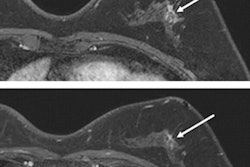
Artificial intelligence (AI) can help detect more cancers and be used in consensus decision-making compared with radiologists alone. That's the view of an experienced European breast imaging specialist.
At RSNA 2022, Dr. Axel Graewingholt from Mammographiescreening-Zentrum Paderborn in Germany presented new results from his team's study, which showed that compared to the time period before AI installation, AI detected 1.2 more cancers on average.
"This means an increase by 27% in cancer detection rate," Graewingholt told delegates in Chicago. "This shows the potential benefit of AI."
In the German screening program, women ages 50 to 69 without any clinical suspicion of breast cancer are invited to attend mammography screening every two years. Double reading is also employed.
Graewingholt and colleagues wanted to compare the diagnostic accuracy of radiologists in a population-based screening program before and after an AI tool (iCAD ProFound AI, version 2.0) was installed at the Paderborn facility.
To do so, the researchers compared performances in two time periods. The first is a 10-year period of screening with full-field digital mammography from 2009 to 2019. Here, five experienced radiologists interpreted images. Graewingholt said these radiologists interpret "a minimum" of 5,000 mammograms a year. If either one or both radiologists detect a suspicious lesion, a consensus panel is used to review cases for recall.
The second period includes 14 months of screening with full-field digital mammography from July 2019 to August 2020. Here, two of the five radiologists had access to AI for their reading process. Consensus review also included use of the AI tool.
"I couldn't convince the others [radiologists] to use the AI before we did this study," Graewingholt said.
The researchers reported that the first period had a total of 322,793 reads with 1,451 true positives. The post-AI period meanwhile had a total of 30,824 reads with 174 true positives. The team also found higher cancer detection rates in the post-AI period, along with higher abnormal interpretation rates.
| Comparison between pre- and post-AI installation periods in detecting breast cancer | ||
| Pre-AI | Post-AI | |
| Cancer detection rate (per 1,000) | 4.54 | 5.78 |
| Abnormal interpretation rate | 4.56% | 4.84% |
Graewingholt said these results show that AI can be beneficial in breast cancer diagnostic settings, though validation studies will be needed since the second period in the study was just 14 months.
"We're still studying the AI in a larger time period to validate the findings of period two, to see if the results are consistent," he noted. "I can tell you that they are consistent."
He added that future research may also focus on cancer characteristics.



















